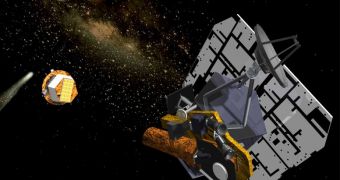Deep Impact hit the history books more than two years ago, when it carried out a mission that involved the study of comet 9P/Tempel, which included impacting the main body of the comet with an impactor, in order to determine its composition and, most importantly, its core density. Nevertheless, NASA has no plans to retire the spacecraft any time soon.
Furthermore, it has recently received the mission to study the comet Hartley 2 with which it will meet somewhere around 2010. Until then however, it must execute a series of maneuvers that ensure the correct trajectory and the necessary speed to rendezvous with the comet. Originally, flight engineers took into consideration the possibility of studying the 85P/Boethin comet, albeit they were greatly disappointed to find that Boethin was nowhere to be found on the night sky.
Why Boethin hasn't been spotted on its predicted orbit remains a mystery so far and it might have something to do with the fact that it was only observed three times in the history of mankind, and could have disintegrated during its last fly-by around the Sun, which was not visible from Earth, or the trajectory might have been greatly miscalculated and, thus, the astronomers were looking for it in the wrong part of the sky.
The approach to Earth that took place on New Year's Eve, and that brought Deep Impact to only 16,000 kilometers to Earth, is the first of the three scheduled flybys the spacecraft must execute to make trajectory corrections and to gather speed with the help of the planet's power gravitational field, through the slingshot effect.
Deep Impact became, in 2005, the first spacecraft studying comets to release an impactor towards the main body of the comet, in order to determine its internal composition. Though the new mission it received, the so-called Epoxi mission, consists in studying the Hartley 2 comet without the release of an impactor, the mothership spacecraft will still provide valuable data by observing the comet in different light wavelengths.
The total distance Deep Impact must travel until its flyby around Hartley 2 equals more than 2.5 billion kilometers and, by the time of the rendezvous, it will be located at a distance of about 19 million kilometers away from Earth. It will then position itself in an orbit around the body about 880 kilometers above its surface. It may seem that NASA engineers have deviated a long way just to study a comet, which it will encounter in more than two years, instead of waiting for the arrival of comet Boethin; however, the two are mostly identical regarding the gas outbursts and general surface activity, and there may be the chance that Boethin will never come back.
During its two-year trip, Deep Impact will have, as a secondary mission, the job of looking for exoplants similar to Earth, around five near stars that are known to have gas giants comparable in size to planet Jupiter.

 14 DAY TRIAL //
14 DAY TRIAL //